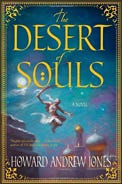A throwback to sword-and-sorcery tales of yore, The Desert of Souls begins in Baghdad in the ninth century, the time of the great Caliph Haroun al-Rashid. Asim, captain of Jaffar's guard, seeking to console his master over the death of his favorite parrot, impulsively suggests a distraction. One thing leads to another, prophecies are made, a fateful encounter ensues, and soon Asim and his bookish friend Dabir are crossing the barren sands in hot pursuit of a villain who has stolen a priceless artifact. Jaffar's beautiful, intelligent but capricious niece complicates their plans. Worst of all, the artifact, which once ornamented the lost city of Ubar, is valuable not only for its gold, rubies and exquisite workmanship. It may open a magical portal into Ubar's catastrophic past. The man into whose hands it has fallen is no ordinary thief.
The research underpinning this novel draws from both the factual history of Baghdad and the exotic magic of the Thousand and One Nights. Islam is treated with a respect woven naturally and casually into the flow of the story without awkward "political correctness." Denizens of the desert range from the strange but true, like a lizard that "swims" under the sand, to a monstrous djinn who covets the souls of men. "The whirlwind slowed ... and the crimson smoke swirled into its form, coloring its bands and striations that spun until the whole of the thing was red as a battlefield. The smoke then diminished, and the djinn cloud ceased its whirling. A powerfully built man was revealed at its center. He was all of varied shades of red ... and the wind raked his hair."
The author, inspired by the novels of Harold Lamb and Robert E. Howard, obviously had tremendous fun writing The Desert of Souls. Readers who enjoy an adventurous, fantastical, sword-wielding romp in that ultimate world of mystery and magic, the past, will have fun with it, too. (2011; 309 pages, including an Afterword regarding sources and the history behind the story)




